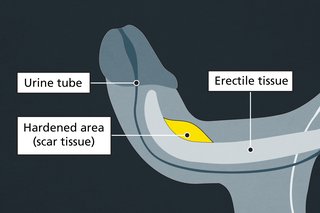Peyronie's disease
Check if it's Peyronie's disease
Peyronie's disease mainly affects men over 40, but younger men can also get it. It can affect any adult with a penis.

Multimedia Team - nhs.uk
Symptoms of Peyronie's disease include:
- swelling that later causes a hard lump to develop on the shaft of your penis and stops it stretching during erections
- a curve in your penis when it's erect (if the hard area is on the top of your penis it will curve upwards, if it's on the bottom it will curve downwards)
- painful erections that can make having sex difficult
- problems getting or keeping an erection (erectile dysfunction)
- other changes to your penis – for example, you may have a hard area on the top, bottom and side of your penis, shortening it and making it narrower in the middle
If you have Peyronie's disease, your skin may also be thicker and less flexible in other parts of your body, such as in your hands and feet.
For example, some men with Peyronie's can also have a condition called Dupuytren's contracture.
Penises vary a lot in size and shape. There may naturally be a slight curve in your penis when it's erect. But get medical help if your penis curves a lot or erections are painful.
Non-urgent advice: See a GP if:
- you have swelling or a hard lump on your penis
- your penis curves upwards or downwards when it's erect
- you have painful erections, or problems getting or keeping an erection, which make having sex difficult
Do not feel embarrassed about getting help. Peyronie's disease is a common problem that GPs are used to dealing with.
What happens at your GP appointment
If a GP thinks you might have Peyronie's disease, they'll ask about your symptoms and will usually need to examine your penis.
They may refer you for an ultrasound scan.
Treatments for Peyronie's disease
If you have Peyronie's disease and your symptoms are mild, treatment may not be needed.
But you may need treatment if your symptoms are severe or causing problems, such as pain during sex, depression or low self-esteem.
Treatments for Peyronie's disease include:
- medicines to slow down the growth of the hard area on your penis or to treat erectile dysfunction
- a procedure that uses sound waves to break down the hard area on your penis
- surgery to straighten your penis (it's not usually possible to straighten it to how it was before it curved)
There are also devices that may help. But they need to be used every day for several months and are not usually available on the NHS.
Causes of Peyronie's disease
The cause of Peyronie's disease is not always known.
It can sometimes happen if you injure your penis.
You're also more likely to get Peyronie's disease if you:
- have diabetes
- have high blood pressure
- have high cholesterol
- have coronary heart disease
- have thickened blood vessels in your heart (arteriosclerosis)
- are taking certain medicines, such as beta blockers or antidepressants
There may sometimes be a family history of Peyronie's disease.
Page last reviewed: 3 June 2024
Next review due: 3 June 2027